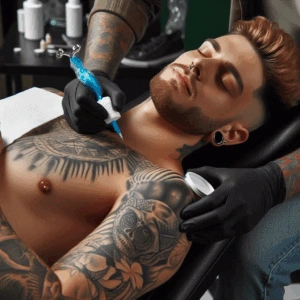Pain is normally a major concern when it comes to tattoos and most of the people who want to get tattooed. What if, however, it were possible to make the process of getting tattooed less painful without sacrificing quality? Welcome to tattoo numbing cream. These creams have revolutionized the game of the tattoo industry, offering an effective solution in reducing pain, anxiety, and discomfort throughout a session. However, how do they work, and why should they be a staple in every tattoo parlor?
How Does Numbing Cream Work on the Skin?
Numbing cream is a topical surface anesthetic which has a momentary numbing effect on the surface of the skin to reduce the pain brought by tattooing, piercing, as well as tiny surgery.

Any active component for most of the numbing creams like lidocaine helps hinder the message flow of the pains from nerve ends to the brain. Numbing creams applied as required let an individual complete a tattoo sitting in a considerably smaller amount of discomfort.
How Are Numbing Creams Different from Other Pain-Relief Procedures?
While other methods of pain relief like oral medication or topical gels might be suitable for some instances, tattoo numbing creams aim to tackle pain at its root. In contrast to oral medication, numbing creams lead to localized pain relief without systemic side effects, resulting in a more safer and productive experience for tattoo clients.
Why Should Tattoo Parlors Offer Numbing Cream?
How Does Numbing Cream Improve Client Comfort?
Client comfort is crucial in any tattoo parlor. To offer numbing cream as an option can help a person in many ways, as much as their overall experience of getting a tattoo goes. For individuals who are afraid of being hurt, being able to get numbing cream can put them at ease, whereby they might be more willing to have a session. The outcome is less tension and positive vibes in the shop.
May Numbing Cream Get More Clients?
Yes! Tattoo stores that offer numbing cream have more potential clients. Clients who might not have been ready to get tattooed due to fear of pain can be willing to visit a store that offers a painless experience. Incorporating numbing cream into your services enables you to reach more people and enhance client satisfaction and loyalty.
Is Providing Numbing Cream Beneficial for Repeat Business?
Definitely. When clients feel less pain, they will be more likely to come back for more tattoos. Providing numbing cream demonstrates your dedication to client comfort, which is important in building long-term relationships. Happy clients are also more likely to refer your studio to their friends and family, resulting in new business.
What Makes the Best Tattoo Numbing Cream?
What Ingredients Should You Look for in a Good Quality Numbing Cream?
The key to an effective numbing cream is in active ingredients. Opt for creams with high-strength painkiller compounds like lidocaine, a safe and widely used local anesthetic. Creams incorporating moisturizers and soothing agents like aloe vera or vitamin E may also be added benefits to the tattooing process by calming irritations and feeding the skin.
How Does the Application Process Affect the Effectiveness?
Correct usage is important for numbing creams to be effective. Make sure the cream is applied liberally onto the skin and left on for the specified duration to allow deep penetration. It’s also important to carefully adhere to the manufacturer’s instructions to yield the best results. Wrong usage can result in ineffective pain reduction.
What Are the Benefits of Using Numbing Cream During Tattoos
Use of numbing cream is in many ways beneficial, including minimizing pain, lower anxiety, and a generally smoother tattooing experience. It allows the artist to work more precisely, as the client will remain still and be relaxed. It also lowers the need for continuous breaks, thereby making the process of tattooing quicker and more efficient.
Can Numbing Cream Be Used for Any Tattoo Design?
Are There Any Tattooed Areas That Are More Sensitive?
Yes, some parts of the body are more sensitive than others, such as the ribs, elbows, knees, and spine. These areas may be harder to work with during a tattoo session, and using numbing cream can make it easier to work with. However, keep in mind that the effectiveness of numbing cream will vary by skin type and the area of the body being tattooed.
Are There Any Limitations to Numbing Cream for Tattoos?
Although numbing cream can make a big difference in pain reduction, it may not eliminate all discomfort, particularly on parts of the body with thick nerve endings. Certain clients can also have mild skin reactions or irritation, so it’s essential to perform a patch test before applying the cream to larger skin areas.